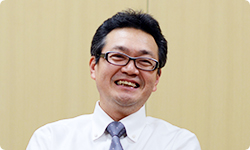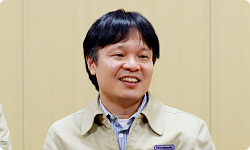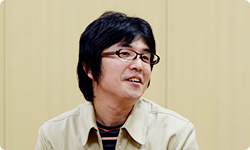You received the algorithm12 developed by Panasonic, which added a special essence that a conventional activity meter doesn’t have. How did development of Fit Meter begin?12. Algorithm: A specific method or procedure for processing information. Here, it means a variety of methods and computations for calculating burned calories.
First, we thought about what kind of activity meter we could make that would be right for Nintendo – and I wanted one for use when hiking in the mountains!
Oh, so it began with your hobby?
Absolutely! (laughs)

I never suspected the Fit Meter began that way!
It did! (laughs) Then we focused on exercise intensity. For example, climbing stairs is about eight METs13 of activity. But the usual activity meter isn’t that accurate.13. Eight METs: A single MET represents a sitting position at rest. Intense running is 13 METs. Light walking is four METs. Vacuuming the floor is three METs. Carrying something heavy is eight METs.
That’s right. I try to use the stairs at lunch, but climbing to the seventh floor without using the elevator is pretty hard.
Stairs are hard. Eight METs is actually a fair amount of exercise. When I ride a bicycle, I always wear a heart rate monitor and measure speed and number of rotations, but it has an atmospheric pressure sensor and can measure altitude changes. It’s encouraging to know you’ve climbed a hill, so I asked Matsunaga-san and Hayashi-san to include an atmospheric pressure sensor in the Fit Meter.
This really did start with your hobbies! Matsunaga-san, what did you think when he asked to include an atmospheric pressure sensor?
Sugiyama-san actually showed me a graph of changes in elevation from when he cycles, but to be honest, at first I didn’t see what was interesting about it at all.
(laughs)
At first, there was zero resonance between you and the rest of the group. (laughs)
(pointing at Matsunaga-san and Hayashi-san) To be frank, these two don’t work out much!
The team of Wii Fit U directors aren’t active! (laughs)
I haven’t really hiked up mountains before, so (glancing at Hayashi-san) h-how is it?
Well, it’s good for people who hike up mountains, but at the time, I still hadn’t grasped what was interesting about it either.
While we still weren’t entirely convinced, we went to ask Panasonic anyway.

Sorry they had so little faith! (laughs)
No, not at all! (laughs) Theoretically, I thought the atmospheric pressure sensor would go in. But hiking in the mountains wasn’t really among our goals.
Your usual targets were those undergoing metabolic screening, so people who enjoy hiking in the mountains must have been a bit far from Panasonic’s product development.
Sort of! (laughs) The challenge was how to test the activity meter with an atmospheric pressure sensor inside. We needed to measure activity of a certain duration and intensity, so we used the stairs of a tall building for our experiments.
You had to continuously climb stairs for a set time, like five or ten minutes.
Right. (laughs wryly)
Wow… that’s what you had to do…
It must have been like a boot camp for those that were measuring.
They used a metronome and ascended step-by-step to a set rhythm.
(holding his head) With a metronome?
And some of them would still give out partway through!
Then that data would be no good.
Not at all. We had to do it again.
It’s thanks to those who climbed stairs to the rhythm of a metronome that we can measure calories so well. Now I understand that in order to correctly measure hard exercise, someone has to exercise hard to provide the data. It isn’t all theory.
That’s right. (laugh)
How did it feel to have made an activity meter that can measure burned calories along with altitude changes?
It shows detailed graphs for going up and down stairs, so it’s easier to see where you did what kind of activities. You can see your own activity patterns, and I think it’s good how you can see burned calories in detail.
Matsunaga-san and Hayashi-san, you weren’t sure at first, so how was it for you?
Yeah. (laughs) The first time I clipped it on and displayed the records on a graph, I was convinced for the first time. Sugiyama-san’s was someone else’s graph, so I guess it didn’t hit home.
It’s much more convincing to see your own graph.
Sorry. (laughs wryly) That was when I first realised how fun it is to look back at my own activities.
How about you, Hayashi-san?
During testing, we could see METs without taking altitude changes into account, as well as METs taking those changes into account. Taking altitude changes into account really conveys how much you’re being active – even though I knew beforehand that climbing stairs was good for you.

It’s rewarding to see numerical values for even the most modest amounts of activities you do in daily life.
Yes. It serves as motivation for using stairs more.
Sugiyama-san, you’re all smiles as you listen. Was that the reaction you hoped for? These two weren’t convinced at first, so you look like you want to say, “I told you so!” (laughs)
Absolutely! (laughs) I actually tested it hiking in the mountains, and I expected it to have satisfying results. But a remaining challenge was seeing whether changes in elevation would properly show up. To test that, I climbed Mount Inari14 quite often!14. Mount Inari: A mountain in Fushimi Ward, Kyoto Prefecture. It stands 232 metres above sea level and is at the southern tip of the Higashiyama Thirty-six Peaks. It is the holy mountain for the shrine Fushimi-Inari Taisha.
Multiple times?
Yes. I did that until I reached acceptable exercise intensity.
Toward the end of development, he was doing it about twice a day.
In addition to altitude changes, did you make any other big requests to Panasonic?
We also asked for development of the Fit Meter software. The Pokéwalker 15 was actually the basis for the Fit Meter, so at the same time, we thought about what to display on the LCD.
15. Pokéwalker: A pedometer packaged with Pokémon HeartGold Version and Pokémon SoulSilver Version, software released for the Nintendo DS system in March 2010. It can hold a favourite Pokémon caught in those games, as well as help catch wild Pokémon and search for items.
Did you make it based on specifications written by Nintendo?
Yes. I explained to Panasonic specifications that I had collated, but at first I didn’t know how to organise them and arranged them like they were specifications for a game. I caused them some trouble.
In other words, Hayashi-san was an amateur in this field, so he made specs completely unlike those you would make at Panasonic. Did that confuse you?
Well, we were, um… confused! (laughs)
(laughs)
It may be a difference in corporate cultures, but once we draw up specs, we barely change them afterward. But I think Nintendo gradually polishes the product specs as development progressed.
Right.
Since you aren’t used to that, it must have been hard when they asked you to change something you had assumed was set.
Yes. That happened a lot.
…. Right. Sorry about that.
Matsunaga-san and Hayashi-san have been smiling wryly and nodding quietly! (laughs)
© 2024 Nintendo.